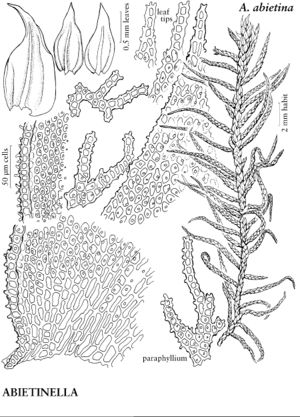Abietinella
Nuovo Giorn. Bot. Ital., n. s. 3: 115. 1896.
| Taxon | Illustrator ⠉ | |
|---|---|---|
 | Abietinella abietina | Patricia M. Eckel |
Plants large. Stems erect-ascending, 1-pinnate; paraphyllia filamentous to narrowly foliose, simple or branched; axillary hairs 2-celled, cells brown. Stem-leaves ovate; margins recurved at least proximally, crenulate-papillose; costa 3/4 leaf length; laminal cells rhombic to oblong-hexagonal, 1-papillose on both surfaces. Branch leaves ovate; margins plane, crenulate-papillose; apex acute to broadly acuminate; costa 3/4 leaf length, not covered with cells apically; laminal cells roundedquadrate to short-rectangular, 1-papillose on both surfaces. Sexual condition dioicous; perichaetial leaves oblong-lanceolate, margins strongly serrate distally, costa subpercurrent, laminal cells porose. Seta smooth. Capsule inclined, cylindric, arcuate; annulus 2-seriate or 3-seriate; operculum obliquely short-rostrate; endostome segments narrowly perforate, cilia 1 or 2.
Distribution
North America, Europe, Asia
Discussion
Species 3 (1 in the flora).
Abietinella is a genus easy to recognize in the flora area; the plants are characterized by relatively robust, stiff, more or less erect, 1-pinnate, paraphylliate stems, often golden brown, growing most often on fairly dry, mostly calcareous sands.
Selected References
None.